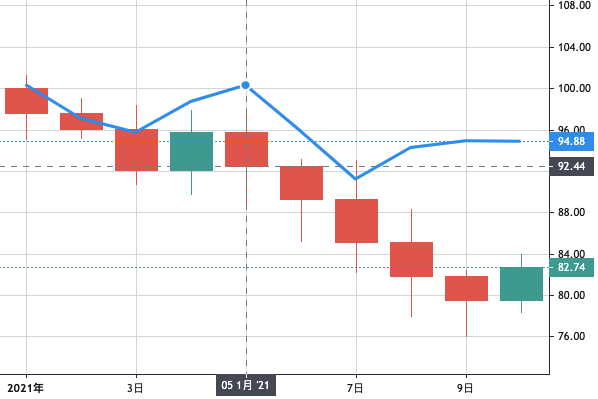Minimal example#
This example shows the most simple way to put up a chart using dash_tvlwc.
Import dependencies
import dash
from dash import html
import dash_tvlwc
Make some random candlestick data and line plot data
candlestick_data = [
{'close': 97.56, 'high': 101.29, 'low': 95.07, 'open': 100, 'time': '2021-01-01'},
{'close': 96.06, 'high': 99.06, 'low': 95.17, 'open': 97.56, 'time': '2021-01-02'},
{'close': 92.06, 'high': 98.39, 'low': 90.72, 'open': 96.06, 'time': '2021-01-03'},
{'close': 95.74, 'high': 97.87, 'low': 89.75, 'open': 92.06, 'time': '2021-01-04'},
{'close': 92.44, 'high': 97.5, 'low': 88.56, 'open': 95.74, 'time': '2021-01-05'},
{'close': 89.31, 'high': 93.1, 'low': 85.20, 'open': 92.44, 'time': '2021-01-06'},
{'close': 85.10, 'high': 93.08, 'low': 82.23, 'open': 89.31, 'time': '2021-01-07'},
{'close': 81.87, 'high': 88.34, 'low': 77.97, 'open': 85.10, 'time': '2021-01-08'},
{'close': 79.55, 'high': 82.44, 'low': 76.08, 'open': 81.87, 'time': '2021-01-09'},
{'close': 82.74, 'high': 84.01, 'low': 78, 'open': 79.55, 'time': '2021-01-10'}
]
line_data = [
{'time': '2021-01-01', 'value': 100.35},
{'time': '2021-01-02', 'value': 97.09},
{'time': '2021-01-03', 'value': 95.74},
{'time': '2021-01-04', 'value': 98.72},
{'time': '2021-01-05', 'value': 100.3},
{'time': '2021-01-06', 'value': 95.8},
{'time': '2021-01-07', 'value': 91.22},
{'time': '2021-01-08', 'value': 94.26},
{'time': '2021-01-09', 'value': 94.9},
{'time': '2021-01-10', 'value': 94.85}
]
Initialize Dash app and add the Tvlwc component
app = dash.Dash(__name__)
app.layout = html.Div(children=[
dash_tvlwc.Tvlwc(
seriesData=[candlestick_data, line_data],
seriesTypes=['candlestick', 'line'],
),
])
if __name__ == '__main__':
app.run_server()
Run the app by
python app2.py. The app should be running onlocalhost:8050/. You should see the plot:
